Creative Skills Assignment 2022
VerifiedAdded on 2022/10/11
|16
|3234
|13
Assignment
AI Summary
Contribute Materials
Your contribution can guide someone’s learning journey. Share your
documents today.
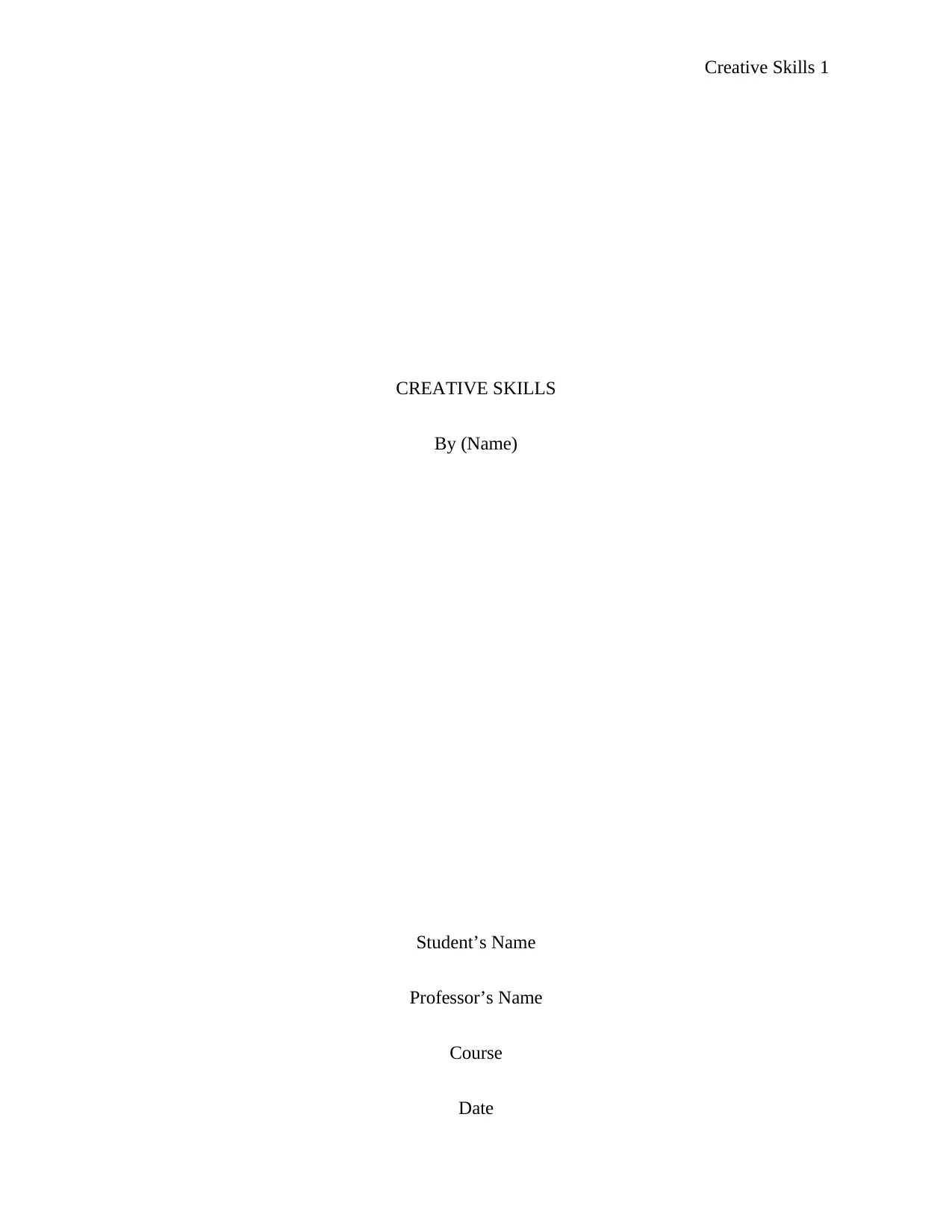
Creative Skills 1
CREATIVE SKILLS
By (Name)
Student’s Name
Professor’s Name
Course
Date
CREATIVE SKILLS
By (Name)
Student’s Name
Professor’s Name
Course
Date
Secure Best Marks with AI Grader
Need help grading? Try our AI Grader for instant feedback on your assignments.
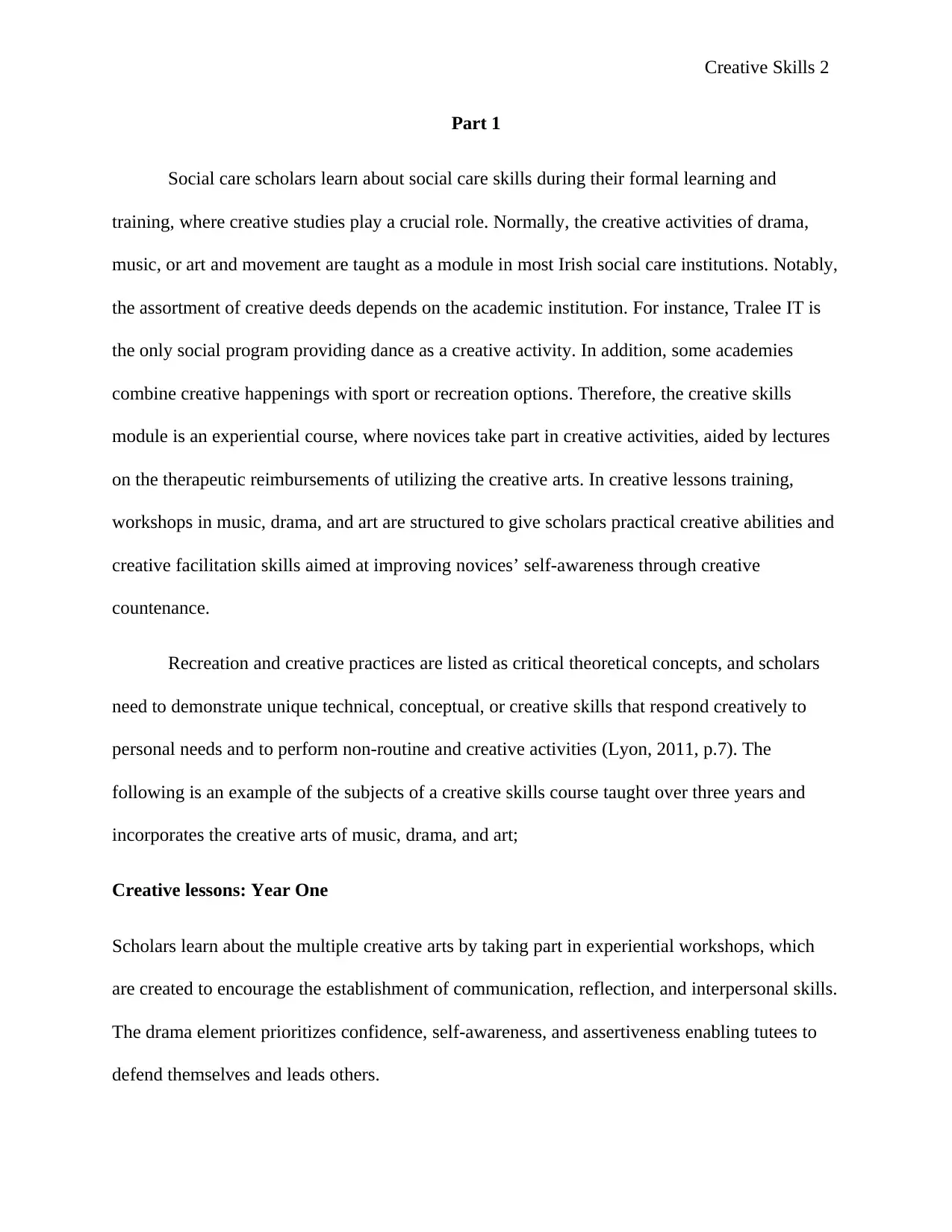
Creative Skills 2
Part 1
Social care scholars learn about social care skills during their formal learning and
training, where creative studies play a crucial role. Normally, the creative activities of drama,
music, or art and movement are taught as a module in most Irish social care institutions. Notably,
the assortment of creative deeds depends on the academic institution. For instance, Tralee IT is
the only social program providing dance as a creative activity. In addition, some academies
combine creative happenings with sport or recreation options. Therefore, the creative skills
module is an experiential course, where novices take part in creative activities, aided by lectures
on the therapeutic reimbursements of utilizing the creative arts. In creative lessons training,
workshops in music, drama, and art are structured to give scholars practical creative abilities and
creative facilitation skills aimed at improving novices’ self-awareness through creative
countenance.
Recreation and creative practices are listed as critical theoretical concepts, and scholars
need to demonstrate unique technical, conceptual, or creative skills that respond creatively to
personal needs and to perform non-routine and creative activities (Lyon, 2011, p.7). The
following is an example of the subjects of a creative skills course taught over three years and
incorporates the creative arts of music, drama, and art;
Creative lessons: Year One
Scholars learn about the multiple creative arts by taking part in experiential workshops, which
are created to encourage the establishment of communication, reflection, and interpersonal skills.
The drama element prioritizes confidence, self-awareness, and assertiveness enabling tutees to
defend themselves and leads others.
Part 1
Social care scholars learn about social care skills during their formal learning and
training, where creative studies play a crucial role. Normally, the creative activities of drama,
music, or art and movement are taught as a module in most Irish social care institutions. Notably,
the assortment of creative deeds depends on the academic institution. For instance, Tralee IT is
the only social program providing dance as a creative activity. In addition, some academies
combine creative happenings with sport or recreation options. Therefore, the creative skills
module is an experiential course, where novices take part in creative activities, aided by lectures
on the therapeutic reimbursements of utilizing the creative arts. In creative lessons training,
workshops in music, drama, and art are structured to give scholars practical creative abilities and
creative facilitation skills aimed at improving novices’ self-awareness through creative
countenance.
Recreation and creative practices are listed as critical theoretical concepts, and scholars
need to demonstrate unique technical, conceptual, or creative skills that respond creatively to
personal needs and to perform non-routine and creative activities (Lyon, 2011, p.7). The
following is an example of the subjects of a creative skills course taught over three years and
incorporates the creative arts of music, drama, and art;
Creative lessons: Year One
Scholars learn about the multiple creative arts by taking part in experiential workshops, which
are created to encourage the establishment of communication, reflection, and interpersonal skills.
The drama element prioritizes confidence, self-awareness, and assertiveness enabling tutees to
defend themselves and leads others.
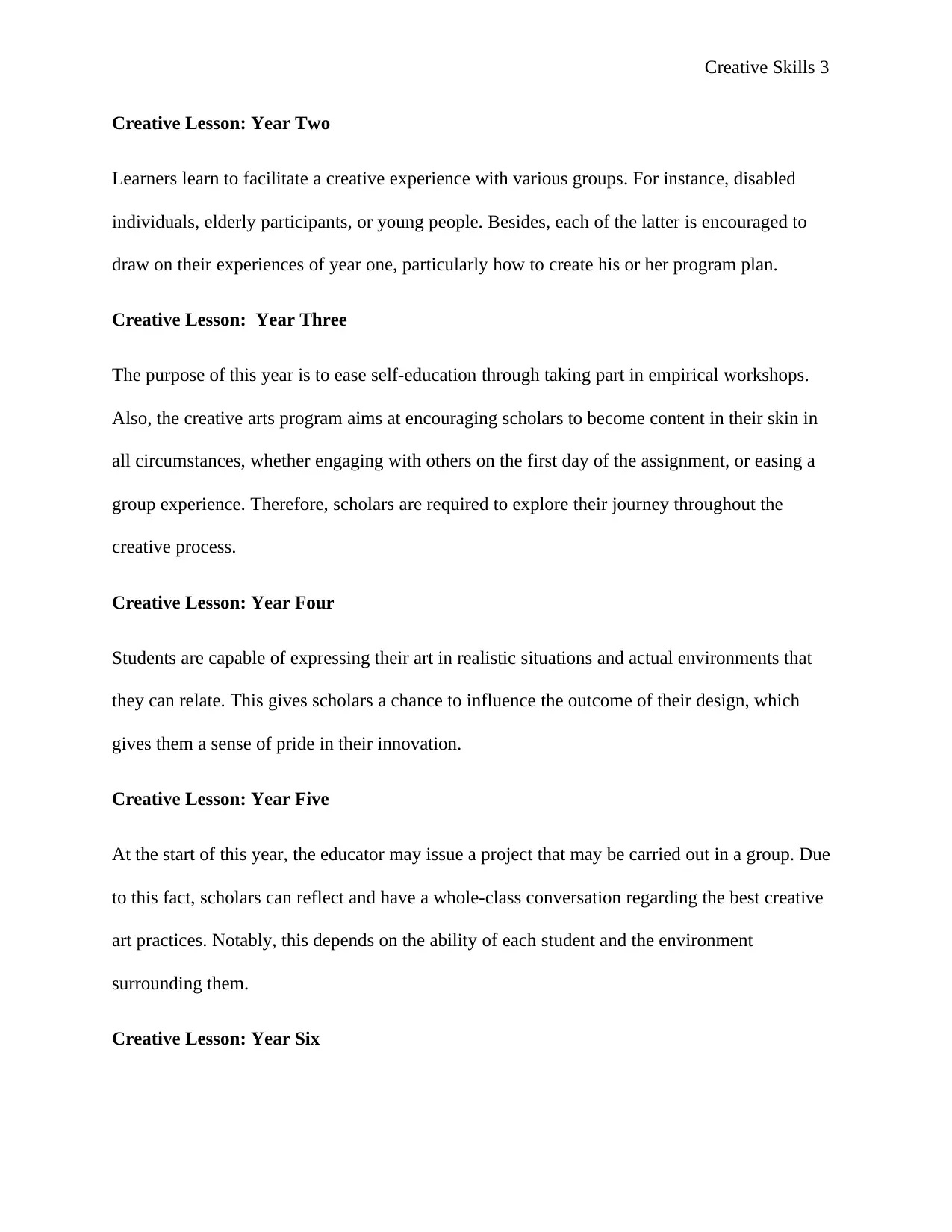
Creative Skills 3
Creative Lesson: Year Two
Learners learn to facilitate a creative experience with various groups. For instance, disabled
individuals, elderly participants, or young people. Besides, each of the latter is encouraged to
draw on their experiences of year one, particularly how to create his or her program plan.
Creative Lesson: Year Three
The purpose of this year is to ease self-education through taking part in empirical workshops.
Also, the creative arts program aims at encouraging scholars to become content in their skin in
all circumstances, whether engaging with others on the first day of the assignment, or easing a
group experience. Therefore, scholars are required to explore their journey throughout the
creative process.
Creative Lesson: Year Four
Students are capable of expressing their art in realistic situations and actual environments that
they can relate. This gives scholars a chance to influence the outcome of their design, which
gives them a sense of pride in their innovation.
Creative Lesson: Year Five
At the start of this year, the educator may issue a project that may be carried out in a group. Due
to this fact, scholars can reflect and have a whole-class conversation regarding the best creative
art practices. Notably, this depends on the ability of each student and the environment
surrounding them.
Creative Lesson: Year Six
Creative Lesson: Year Two
Learners learn to facilitate a creative experience with various groups. For instance, disabled
individuals, elderly participants, or young people. Besides, each of the latter is encouraged to
draw on their experiences of year one, particularly how to create his or her program plan.
Creative Lesson: Year Three
The purpose of this year is to ease self-education through taking part in empirical workshops.
Also, the creative arts program aims at encouraging scholars to become content in their skin in
all circumstances, whether engaging with others on the first day of the assignment, or easing a
group experience. Therefore, scholars are required to explore their journey throughout the
creative process.
Creative Lesson: Year Four
Students are capable of expressing their art in realistic situations and actual environments that
they can relate. This gives scholars a chance to influence the outcome of their design, which
gives them a sense of pride in their innovation.
Creative Lesson: Year Five
At the start of this year, the educator may issue a project that may be carried out in a group. Due
to this fact, scholars can reflect and have a whole-class conversation regarding the best creative
art practices. Notably, this depends on the ability of each student and the environment
surrounding them.
Creative Lesson: Year Six
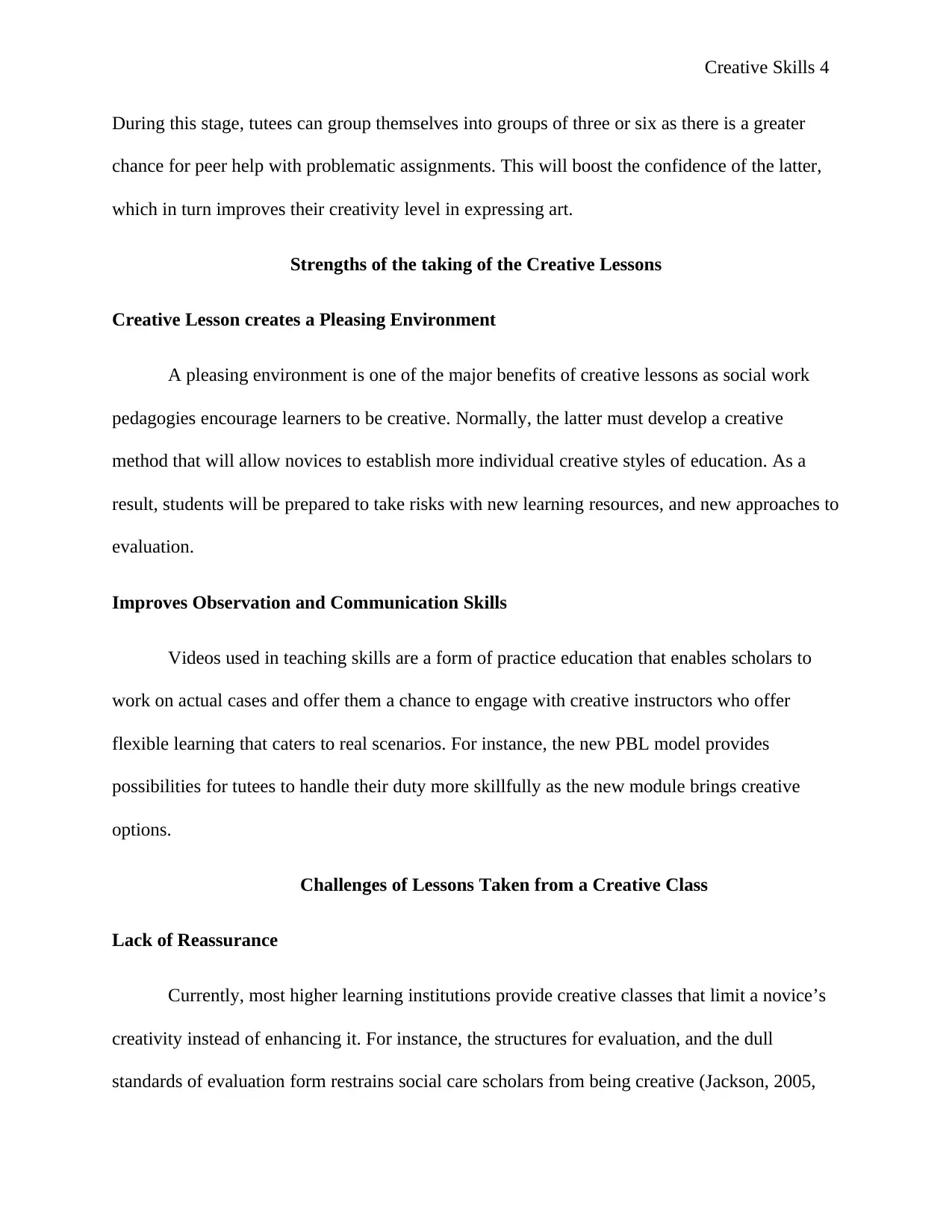
Creative Skills 4
During this stage, tutees can group themselves into groups of three or six as there is a greater
chance for peer help with problematic assignments. This will boost the confidence of the latter,
which in turn improves their creativity level in expressing art.
Strengths of the taking of the Creative Lessons
Creative Lesson creates a Pleasing Environment
A pleasing environment is one of the major benefits of creative lessons as social work
pedagogies encourage learners to be creative. Normally, the latter must develop a creative
method that will allow novices to establish more individual creative styles of education. As a
result, students will be prepared to take risks with new learning resources, and new approaches to
evaluation.
Improves Observation and Communication Skills
Videos used in teaching skills are a form of practice education that enables scholars to
work on actual cases and offer them a chance to engage with creative instructors who offer
flexible learning that caters to real scenarios. For instance, the new PBL model provides
possibilities for tutees to handle their duty more skillfully as the new module brings creative
options.
Challenges of Lessons Taken from a Creative Class
Lack of Reassurance
Currently, most higher learning institutions provide creative classes that limit a novice’s
creativity instead of enhancing it. For instance, the structures for evaluation, and the dull
standards of evaluation form restrains social care scholars from being creative (Jackson, 2005,
During this stage, tutees can group themselves into groups of three or six as there is a greater
chance for peer help with problematic assignments. This will boost the confidence of the latter,
which in turn improves their creativity level in expressing art.
Strengths of the taking of the Creative Lessons
Creative Lesson creates a Pleasing Environment
A pleasing environment is one of the major benefits of creative lessons as social work
pedagogies encourage learners to be creative. Normally, the latter must develop a creative
method that will allow novices to establish more individual creative styles of education. As a
result, students will be prepared to take risks with new learning resources, and new approaches to
evaluation.
Improves Observation and Communication Skills
Videos used in teaching skills are a form of practice education that enables scholars to
work on actual cases and offer them a chance to engage with creative instructors who offer
flexible learning that caters to real scenarios. For instance, the new PBL model provides
possibilities for tutees to handle their duty more skillfully as the new module brings creative
options.
Challenges of Lessons Taken from a Creative Class
Lack of Reassurance
Currently, most higher learning institutions provide creative classes that limit a novice’s
creativity instead of enhancing it. For instance, the structures for evaluation, and the dull
standards of evaluation form restrains social care scholars from being creative (Jackson, 2005,
Secure Best Marks with AI Grader
Need help grading? Try our AI Grader for instant feedback on your assignments.
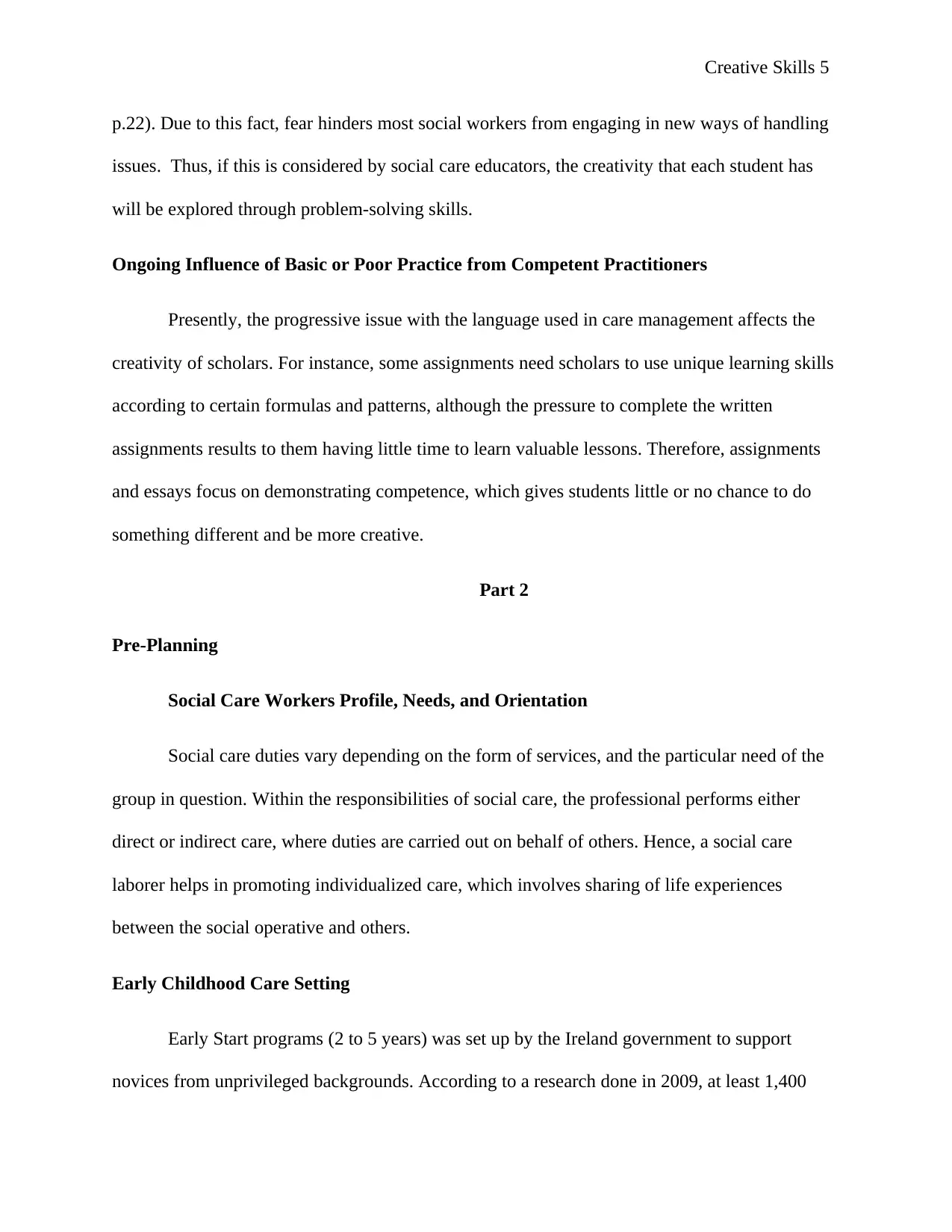
Creative Skills 5
p.22). Due to this fact, fear hinders most social workers from engaging in new ways of handling
issues. Thus, if this is considered by social care educators, the creativity that each student has
will be explored through problem-solving skills.
Ongoing Influence of Basic or Poor Practice from Competent Practitioners
Presently, the progressive issue with the language used in care management affects the
creativity of scholars. For instance, some assignments need scholars to use unique learning skills
according to certain formulas and patterns, although the pressure to complete the written
assignments results to them having little time to learn valuable lessons. Therefore, assignments
and essays focus on demonstrating competence, which gives students little or no chance to do
something different and be more creative.
Part 2
Pre-Planning
Social Care Workers Profile, Needs, and Orientation
Social care duties vary depending on the form of services, and the particular need of the
group in question. Within the responsibilities of social care, the professional performs either
direct or indirect care, where duties are carried out on behalf of others. Hence, a social care
laborer helps in promoting individualized care, which involves sharing of life experiences
between the social operative and others.
Early Childhood Care Setting
Early Start programs (2 to 5 years) was set up by the Ireland government to support
novices from unprivileged backgrounds. According to a research done in 2009, at least 1,400
p.22). Due to this fact, fear hinders most social workers from engaging in new ways of handling
issues. Thus, if this is considered by social care educators, the creativity that each student has
will be explored through problem-solving skills.
Ongoing Influence of Basic or Poor Practice from Competent Practitioners
Presently, the progressive issue with the language used in care management affects the
creativity of scholars. For instance, some assignments need scholars to use unique learning skills
according to certain formulas and patterns, although the pressure to complete the written
assignments results to them having little time to learn valuable lessons. Therefore, assignments
and essays focus on demonstrating competence, which gives students little or no chance to do
something different and be more creative.
Part 2
Pre-Planning
Social Care Workers Profile, Needs, and Orientation
Social care duties vary depending on the form of services, and the particular need of the
group in question. Within the responsibilities of social care, the professional performs either
direct or indirect care, where duties are carried out on behalf of others. Hence, a social care
laborer helps in promoting individualized care, which involves sharing of life experiences
between the social operative and others.
Early Childhood Care Setting
Early Start programs (2 to 5 years) was set up by the Ireland government to support
novices from unprivileged backgrounds. According to a research done in 2009, at least 1,400
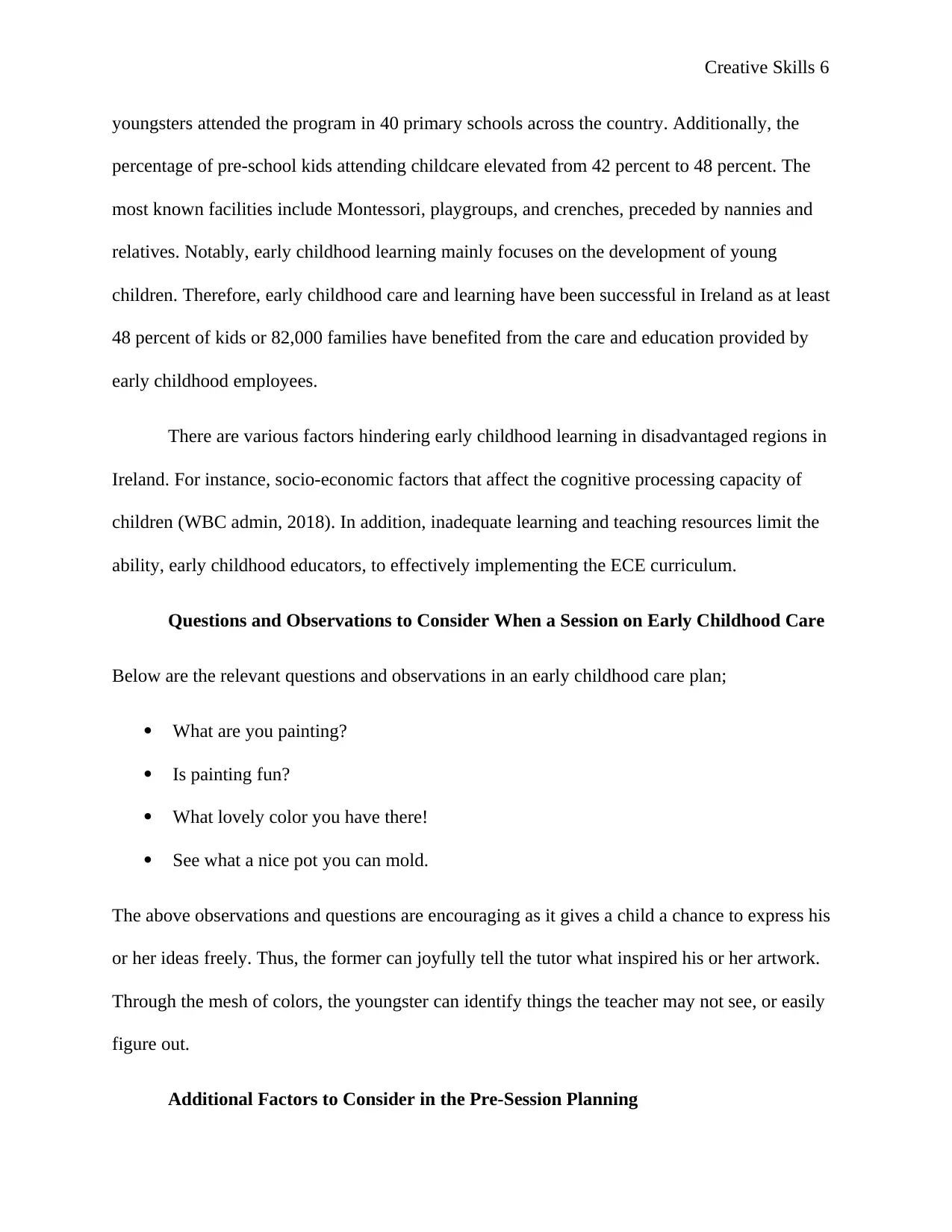
Creative Skills 6
youngsters attended the program in 40 primary schools across the country. Additionally, the
percentage of pre-school kids attending childcare elevated from 42 percent to 48 percent. The
most known facilities include Montessori, playgroups, and crenches, preceded by nannies and
relatives. Notably, early childhood learning mainly focuses on the development of young
children. Therefore, early childhood care and learning have been successful in Ireland as at least
48 percent of kids or 82,000 families have benefited from the care and education provided by
early childhood employees.
There are various factors hindering early childhood learning in disadvantaged regions in
Ireland. For instance, socio-economic factors that affect the cognitive processing capacity of
children (WBC admin, 2018). In addition, inadequate learning and teaching resources limit the
ability, early childhood educators, to effectively implementing the ECE curriculum.
Questions and Observations to Consider When a Session on Early Childhood Care
Below are the relevant questions and observations in an early childhood care plan;
What are you painting?
Is painting fun?
What lovely color you have there!
See what a nice pot you can mold.
The above observations and questions are encouraging as it gives a child a chance to express his
or her ideas freely. Thus, the former can joyfully tell the tutor what inspired his or her artwork.
Through the mesh of colors, the youngster can identify things the teacher may not see, or easily
figure out.
Additional Factors to Consider in the Pre-Session Planning
youngsters attended the program in 40 primary schools across the country. Additionally, the
percentage of pre-school kids attending childcare elevated from 42 percent to 48 percent. The
most known facilities include Montessori, playgroups, and crenches, preceded by nannies and
relatives. Notably, early childhood learning mainly focuses on the development of young
children. Therefore, early childhood care and learning have been successful in Ireland as at least
48 percent of kids or 82,000 families have benefited from the care and education provided by
early childhood employees.
There are various factors hindering early childhood learning in disadvantaged regions in
Ireland. For instance, socio-economic factors that affect the cognitive processing capacity of
children (WBC admin, 2018). In addition, inadequate learning and teaching resources limit the
ability, early childhood educators, to effectively implementing the ECE curriculum.
Questions and Observations to Consider When a Session on Early Childhood Care
Below are the relevant questions and observations in an early childhood care plan;
What are you painting?
Is painting fun?
What lovely color you have there!
See what a nice pot you can mold.
The above observations and questions are encouraging as it gives a child a chance to express his
or her ideas freely. Thus, the former can joyfully tell the tutor what inspired his or her artwork.
Through the mesh of colors, the youngster can identify things the teacher may not see, or easily
figure out.
Additional Factors to Consider in the Pre-Session Planning
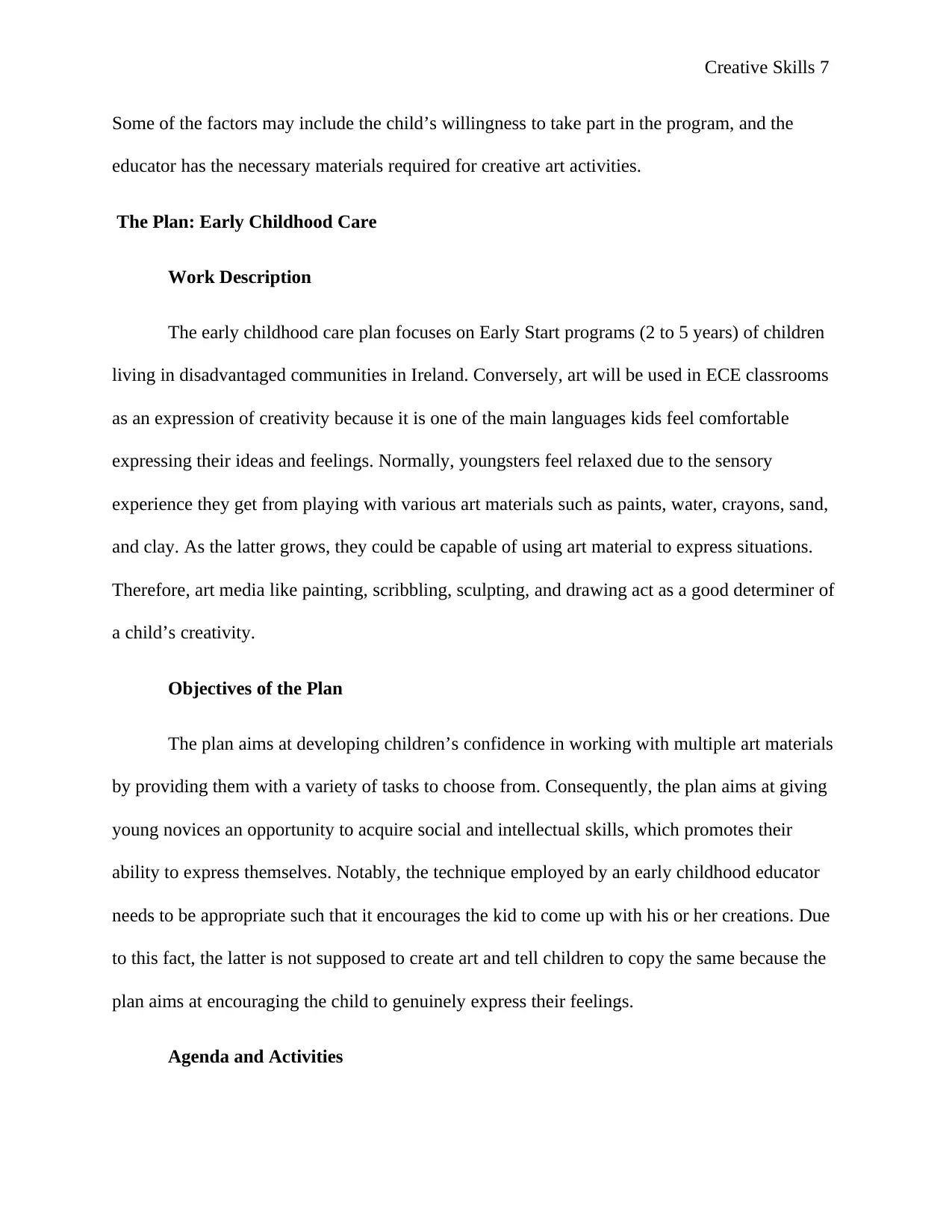
Creative Skills 7
Some of the factors may include the child’s willingness to take part in the program, and the
educator has the necessary materials required for creative art activities.
The Plan: Early Childhood Care
Work Description
The early childhood care plan focuses on Early Start programs (2 to 5 years) of children
living in disadvantaged communities in Ireland. Conversely, art will be used in ECE classrooms
as an expression of creativity because it is one of the main languages kids feel comfortable
expressing their ideas and feelings. Normally, youngsters feel relaxed due to the sensory
experience they get from playing with various art materials such as paints, water, crayons, sand,
and clay. As the latter grows, they could be capable of using art material to express situations.
Therefore, art media like painting, scribbling, sculpting, and drawing act as a good determiner of
a child’s creativity.
Objectives of the Plan
The plan aims at developing children’s confidence in working with multiple art materials
by providing them with a variety of tasks to choose from. Consequently, the plan aims at giving
young novices an opportunity to acquire social and intellectual skills, which promotes their
ability to express themselves. Notably, the technique employed by an early childhood educator
needs to be appropriate such that it encourages the kid to come up with his or her creations. Due
to this fact, the latter is not supposed to create art and tell children to copy the same because the
plan aims at encouraging the child to genuinely express their feelings.
Agenda and Activities
Some of the factors may include the child’s willingness to take part in the program, and the
educator has the necessary materials required for creative art activities.
The Plan: Early Childhood Care
Work Description
The early childhood care plan focuses on Early Start programs (2 to 5 years) of children
living in disadvantaged communities in Ireland. Conversely, art will be used in ECE classrooms
as an expression of creativity because it is one of the main languages kids feel comfortable
expressing their ideas and feelings. Normally, youngsters feel relaxed due to the sensory
experience they get from playing with various art materials such as paints, water, crayons, sand,
and clay. As the latter grows, they could be capable of using art material to express situations.
Therefore, art media like painting, scribbling, sculpting, and drawing act as a good determiner of
a child’s creativity.
Objectives of the Plan
The plan aims at developing children’s confidence in working with multiple art materials
by providing them with a variety of tasks to choose from. Consequently, the plan aims at giving
young novices an opportunity to acquire social and intellectual skills, which promotes their
ability to express themselves. Notably, the technique employed by an early childhood educator
needs to be appropriate such that it encourages the kid to come up with his or her creations. Due
to this fact, the latter is not supposed to create art and tell children to copy the same because the
plan aims at encouraging the child to genuinely express their feelings.
Agenda and Activities
Paraphrase This Document
Need a fresh take? Get an instant paraphrase of this document with our AI Paraphraser
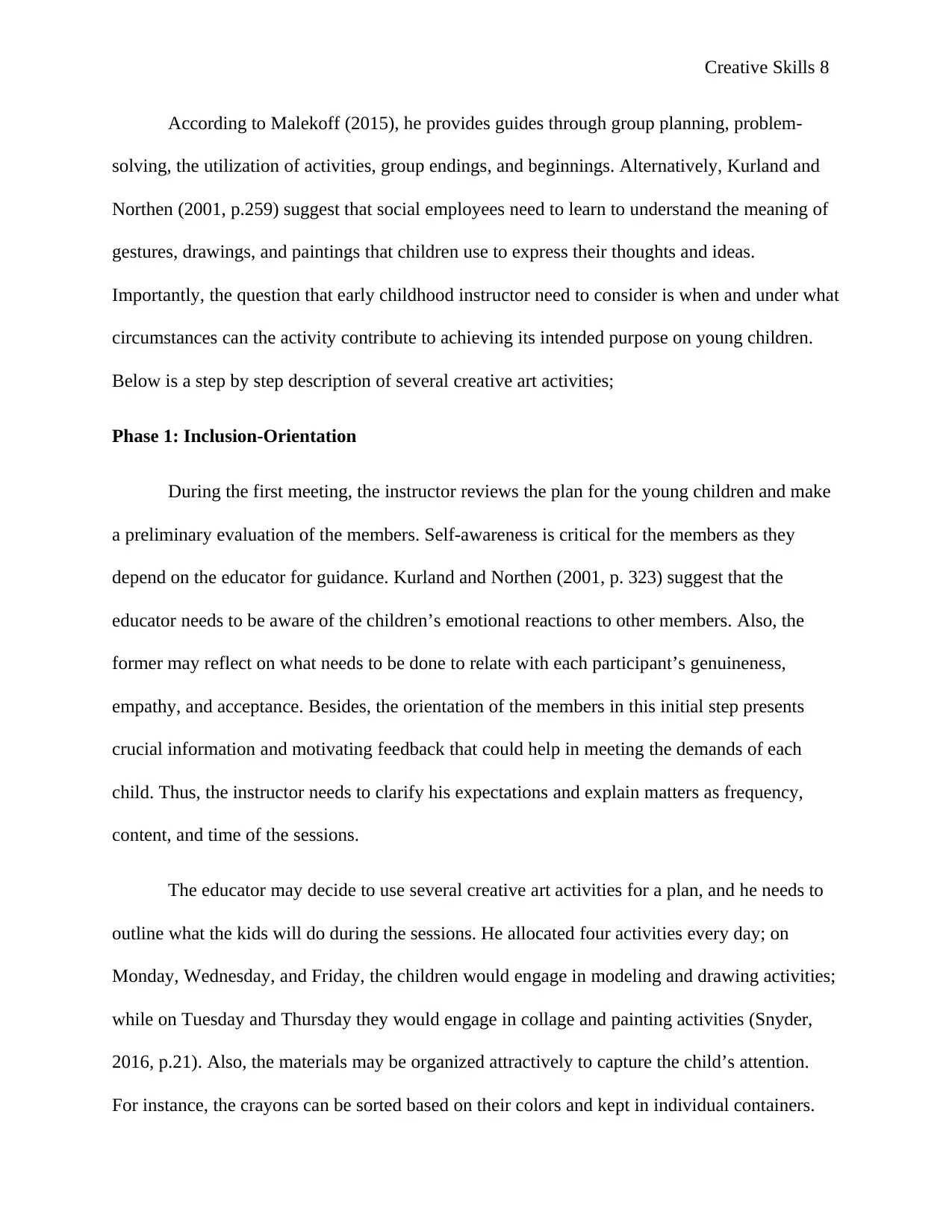
Creative Skills 8
According to Malekoff (2015), he provides guides through group planning, problem-
solving, the utilization of activities, group endings, and beginnings. Alternatively, Kurland and
Northen (2001, p.259) suggest that social employees need to learn to understand the meaning of
gestures, drawings, and paintings that children use to express their thoughts and ideas.
Importantly, the question that early childhood instructor need to consider is when and under what
circumstances can the activity contribute to achieving its intended purpose on young children.
Below is a step by step description of several creative art activities;
Phase 1: Inclusion-Orientation
During the first meeting, the instructor reviews the plan for the young children and make
a preliminary evaluation of the members. Self-awareness is critical for the members as they
depend on the educator for guidance. Kurland and Northen (2001, p. 323) suggest that the
educator needs to be aware of the children’s emotional reactions to other members. Also, the
former may reflect on what needs to be done to relate with each participant’s genuineness,
empathy, and acceptance. Besides, the orientation of the members in this initial step presents
crucial information and motivating feedback that could help in meeting the demands of each
child. Thus, the instructor needs to clarify his expectations and explain matters as frequency,
content, and time of the sessions.
The educator may decide to use several creative art activities for a plan, and he needs to
outline what the kids will do during the sessions. He allocated four activities every day; on
Monday, Wednesday, and Friday, the children would engage in modeling and drawing activities;
while on Tuesday and Thursday they would engage in collage and painting activities (Snyder,
2016, p.21). Also, the materials may be organized attractively to capture the child’s attention.
For instance, the crayons can be sorted based on their colors and kept in individual containers.
According to Malekoff (2015), he provides guides through group planning, problem-
solving, the utilization of activities, group endings, and beginnings. Alternatively, Kurland and
Northen (2001, p.259) suggest that social employees need to learn to understand the meaning of
gestures, drawings, and paintings that children use to express their thoughts and ideas.
Importantly, the question that early childhood instructor need to consider is when and under what
circumstances can the activity contribute to achieving its intended purpose on young children.
Below is a step by step description of several creative art activities;
Phase 1: Inclusion-Orientation
During the first meeting, the instructor reviews the plan for the young children and make
a preliminary evaluation of the members. Self-awareness is critical for the members as they
depend on the educator for guidance. Kurland and Northen (2001, p. 323) suggest that the
educator needs to be aware of the children’s emotional reactions to other members. Also, the
former may reflect on what needs to be done to relate with each participant’s genuineness,
empathy, and acceptance. Besides, the orientation of the members in this initial step presents
crucial information and motivating feedback that could help in meeting the demands of each
child. Thus, the instructor needs to clarify his expectations and explain matters as frequency,
content, and time of the sessions.
The educator may decide to use several creative art activities for a plan, and he needs to
outline what the kids will do during the sessions. He allocated four activities every day; on
Monday, Wednesday, and Friday, the children would engage in modeling and drawing activities;
while on Tuesday and Thursday they would engage in collage and painting activities (Snyder,
2016, p.21). Also, the materials may be organized attractively to capture the child’s attention.
For instance, the crayons can be sorted based on their colors and kept in individual containers.
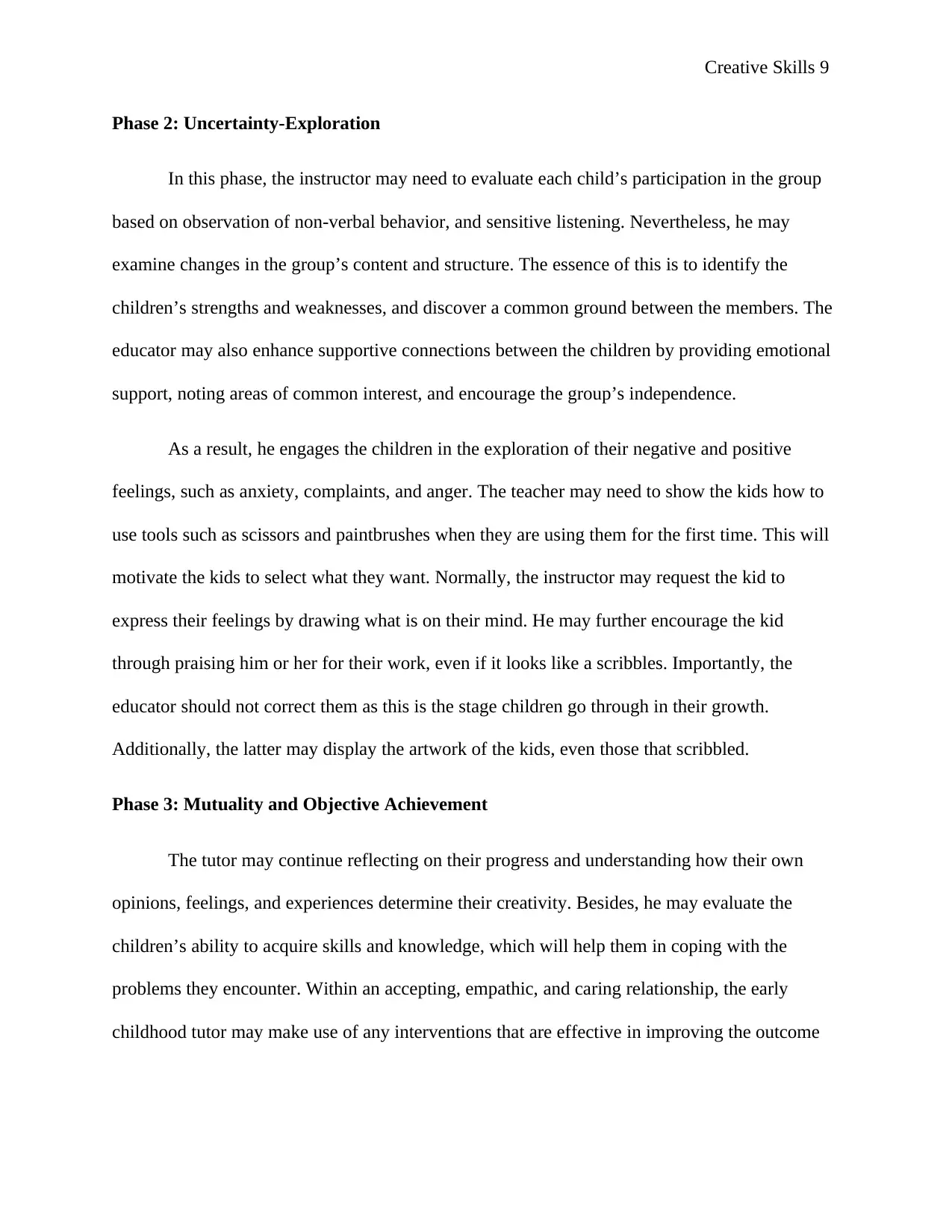
Creative Skills 9
Phase 2: Uncertainty-Exploration
In this phase, the instructor may need to evaluate each child’s participation in the group
based on observation of non-verbal behavior, and sensitive listening. Nevertheless, he may
examine changes in the group’s content and structure. The essence of this is to identify the
children’s strengths and weaknesses, and discover a common ground between the members. The
educator may also enhance supportive connections between the children by providing emotional
support, noting areas of common interest, and encourage the group’s independence.
As a result, he engages the children in the exploration of their negative and positive
feelings, such as anxiety, complaints, and anger. The teacher may need to show the kids how to
use tools such as scissors and paintbrushes when they are using them for the first time. This will
motivate the kids to select what they want. Normally, the instructor may request the kid to
express their feelings by drawing what is on their mind. He may further encourage the kid
through praising him or her for their work, even if it looks like a scribbles. Importantly, the
educator should not correct them as this is the stage children go through in their growth.
Additionally, the latter may display the artwork of the kids, even those that scribbled.
Phase 3: Mutuality and Objective Achievement
The tutor may continue reflecting on their progress and understanding how their own
opinions, feelings, and experiences determine their creativity. Besides, he may evaluate the
children’s ability to acquire skills and knowledge, which will help them in coping with the
problems they encounter. Within an accepting, empathic, and caring relationship, the early
childhood tutor may make use of any interventions that are effective in improving the outcome
Phase 2: Uncertainty-Exploration
In this phase, the instructor may need to evaluate each child’s participation in the group
based on observation of non-verbal behavior, and sensitive listening. Nevertheless, he may
examine changes in the group’s content and structure. The essence of this is to identify the
children’s strengths and weaknesses, and discover a common ground between the members. The
educator may also enhance supportive connections between the children by providing emotional
support, noting areas of common interest, and encourage the group’s independence.
As a result, he engages the children in the exploration of their negative and positive
feelings, such as anxiety, complaints, and anger. The teacher may need to show the kids how to
use tools such as scissors and paintbrushes when they are using them for the first time. This will
motivate the kids to select what they want. Normally, the instructor may request the kid to
express their feelings by drawing what is on their mind. He may further encourage the kid
through praising him or her for their work, even if it looks like a scribbles. Importantly, the
educator should not correct them as this is the stage children go through in their growth.
Additionally, the latter may display the artwork of the kids, even those that scribbled.
Phase 3: Mutuality and Objective Achievement
The tutor may continue reflecting on their progress and understanding how their own
opinions, feelings, and experiences determine their creativity. Besides, he may evaluate the
children’s ability to acquire skills and knowledge, which will help them in coping with the
problems they encounter. Within an accepting, empathic, and caring relationship, the early
childhood tutor may make use of any interventions that are effective in improving the outcome
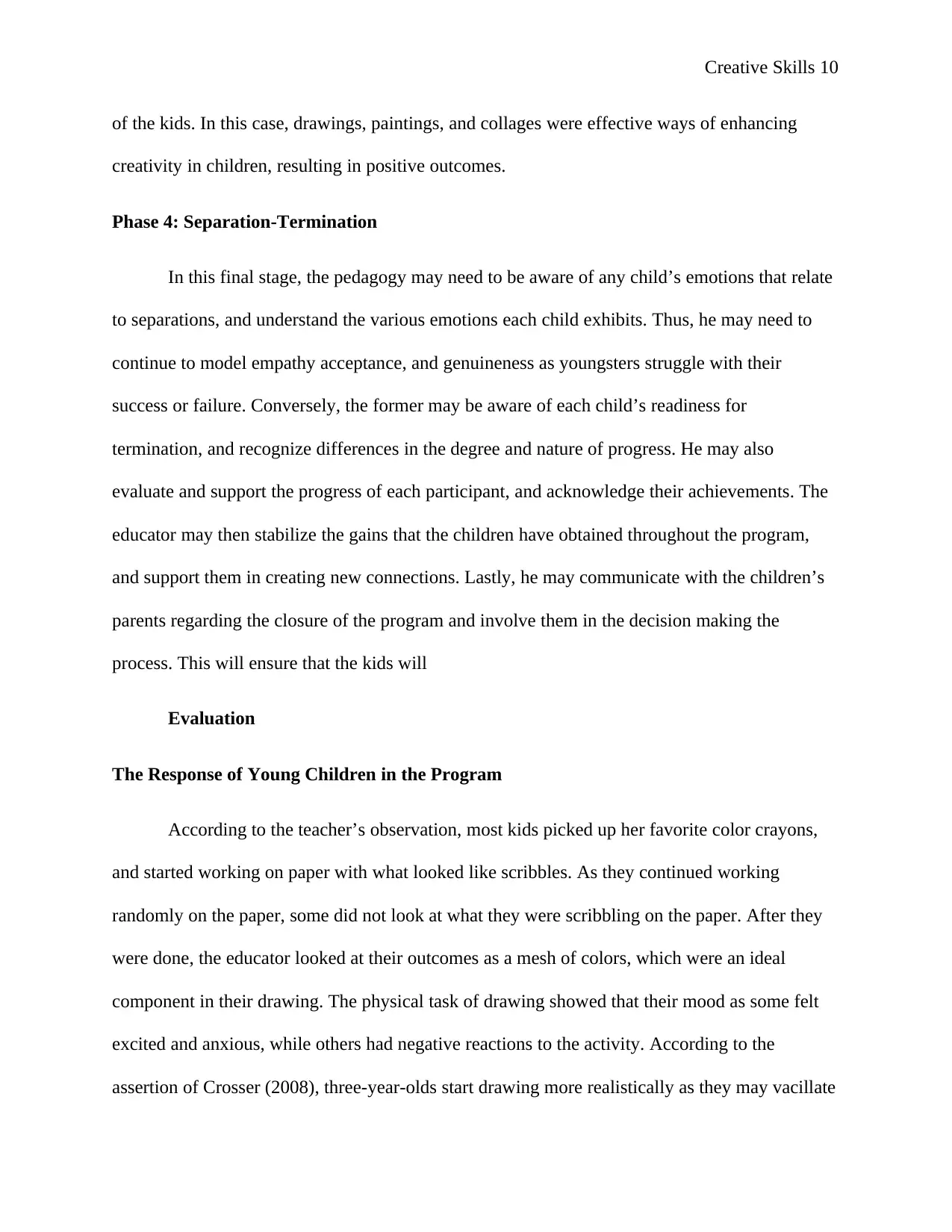
Creative Skills 10
of the kids. In this case, drawings, paintings, and collages were effective ways of enhancing
creativity in children, resulting in positive outcomes.
Phase 4: Separation-Termination
In this final stage, the pedagogy may need to be aware of any child’s emotions that relate
to separations, and understand the various emotions each child exhibits. Thus, he may need to
continue to model empathy acceptance, and genuineness as youngsters struggle with their
success or failure. Conversely, the former may be aware of each child’s readiness for
termination, and recognize differences in the degree and nature of progress. He may also
evaluate and support the progress of each participant, and acknowledge their achievements. The
educator may then stabilize the gains that the children have obtained throughout the program,
and support them in creating new connections. Lastly, he may communicate with the children’s
parents regarding the closure of the program and involve them in the decision making the
process. This will ensure that the kids will
Evaluation
The Response of Young Children in the Program
According to the teacher’s observation, most kids picked up her favorite color crayons,
and started working on paper with what looked like scribbles. As they continued working
randomly on the paper, some did not look at what they were scribbling on the paper. After they
were done, the educator looked at their outcomes as a mesh of colors, which were an ideal
component in their drawing. The physical task of drawing showed that their mood as some felt
excited and anxious, while others had negative reactions to the activity. According to the
assertion of Crosser (2008), three-year-olds start drawing more realistically as they may vacillate
of the kids. In this case, drawings, paintings, and collages were effective ways of enhancing
creativity in children, resulting in positive outcomes.
Phase 4: Separation-Termination
In this final stage, the pedagogy may need to be aware of any child’s emotions that relate
to separations, and understand the various emotions each child exhibits. Thus, he may need to
continue to model empathy acceptance, and genuineness as youngsters struggle with their
success or failure. Conversely, the former may be aware of each child’s readiness for
termination, and recognize differences in the degree and nature of progress. He may also
evaluate and support the progress of each participant, and acknowledge their achievements. The
educator may then stabilize the gains that the children have obtained throughout the program,
and support them in creating new connections. Lastly, he may communicate with the children’s
parents regarding the closure of the program and involve them in the decision making the
process. This will ensure that the kids will
Evaluation
The Response of Young Children in the Program
According to the teacher’s observation, most kids picked up her favorite color crayons,
and started working on paper with what looked like scribbles. As they continued working
randomly on the paper, some did not look at what they were scribbling on the paper. After they
were done, the educator looked at their outcomes as a mesh of colors, which were an ideal
component in their drawing. The physical task of drawing showed that their mood as some felt
excited and anxious, while others had negative reactions to the activity. According to the
assertion of Crosser (2008), three-year-olds start drawing more realistically as they may vacillate
Secure Best Marks with AI Grader
Need help grading? Try our AI Grader for instant feedback on your assignments.
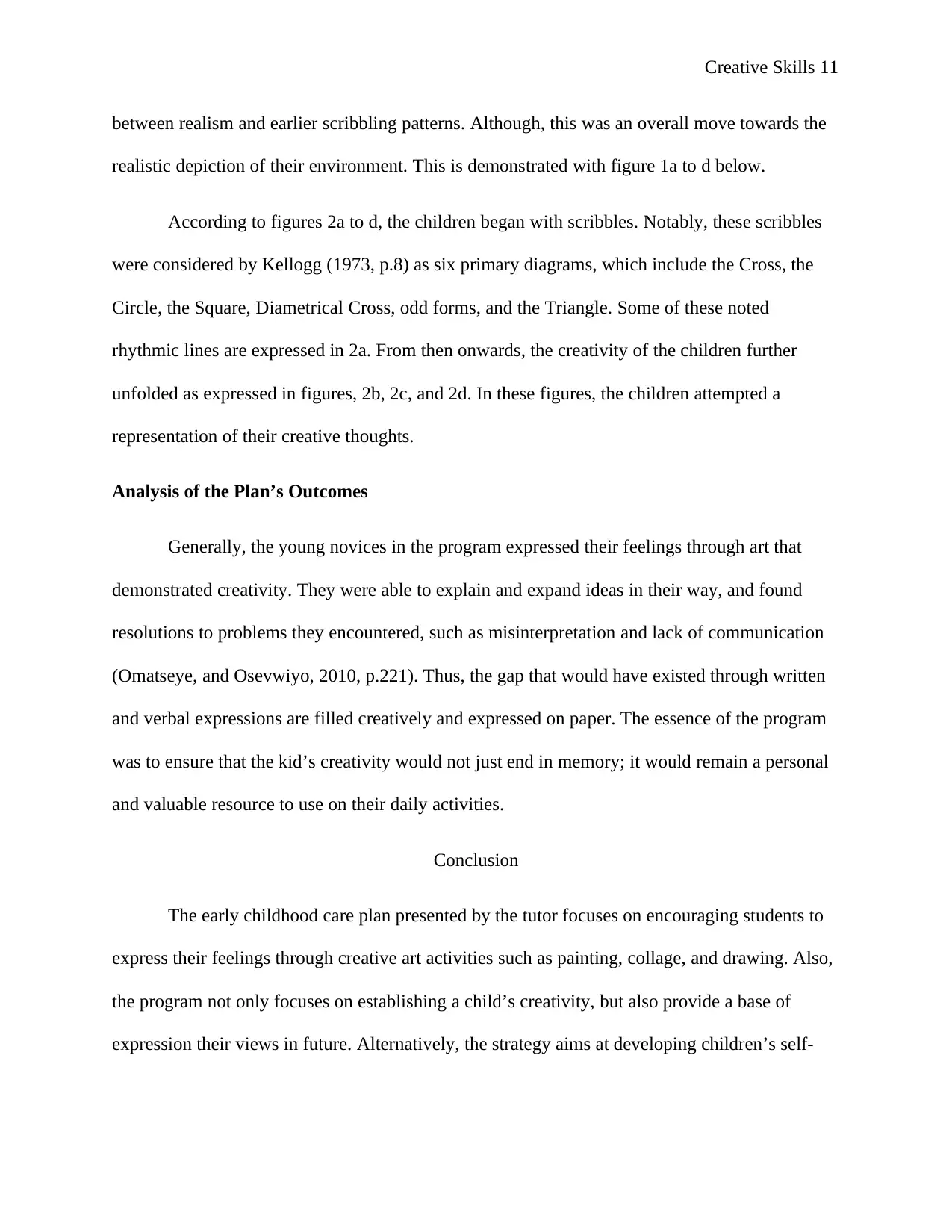
Creative Skills 11
between realism and earlier scribbling patterns. Although, this was an overall move towards the
realistic depiction of their environment. This is demonstrated with figure 1a to d below.
According to figures 2a to d, the children began with scribbles. Notably, these scribbles
were considered by Kellogg (1973, p.8) as six primary diagrams, which include the Cross, the
Circle, the Square, Diametrical Cross, odd forms, and the Triangle. Some of these noted
rhythmic lines are expressed in 2a. From then onwards, the creativity of the children further
unfolded as expressed in figures, 2b, 2c, and 2d. In these figures, the children attempted a
representation of their creative thoughts.
Analysis of the Plan’s Outcomes
Generally, the young novices in the program expressed their feelings through art that
demonstrated creativity. They were able to explain and expand ideas in their way, and found
resolutions to problems they encountered, such as misinterpretation and lack of communication
(Omatseye, and Osevwiyo, 2010, p.221). Thus, the gap that would have existed through written
and verbal expressions are filled creatively and expressed on paper. The essence of the program
was to ensure that the kid’s creativity would not just end in memory; it would remain a personal
and valuable resource to use on their daily activities.
Conclusion
The early childhood care plan presented by the tutor focuses on encouraging students to
express their feelings through creative art activities such as painting, collage, and drawing. Also,
the program not only focuses on establishing a child’s creativity, but also provide a base of
expression their views in future. Alternatively, the strategy aims at developing children’s self-
between realism and earlier scribbling patterns. Although, this was an overall move towards the
realistic depiction of their environment. This is demonstrated with figure 1a to d below.
According to figures 2a to d, the children began with scribbles. Notably, these scribbles
were considered by Kellogg (1973, p.8) as six primary diagrams, which include the Cross, the
Circle, the Square, Diametrical Cross, odd forms, and the Triangle. Some of these noted
rhythmic lines are expressed in 2a. From then onwards, the creativity of the children further
unfolded as expressed in figures, 2b, 2c, and 2d. In these figures, the children attempted a
representation of their creative thoughts.
Analysis of the Plan’s Outcomes
Generally, the young novices in the program expressed their feelings through art that
demonstrated creativity. They were able to explain and expand ideas in their way, and found
resolutions to problems they encountered, such as misinterpretation and lack of communication
(Omatseye, and Osevwiyo, 2010, p.221). Thus, the gap that would have existed through written
and verbal expressions are filled creatively and expressed on paper. The essence of the program
was to ensure that the kid’s creativity would not just end in memory; it would remain a personal
and valuable resource to use on their daily activities.
Conclusion
The early childhood care plan presented by the tutor focuses on encouraging students to
express their feelings through creative art activities such as painting, collage, and drawing. Also,
the program not only focuses on establishing a child’s creativity, but also provide a base of
expression their views in future. Alternatively, the strategy aims at developing children’s self-
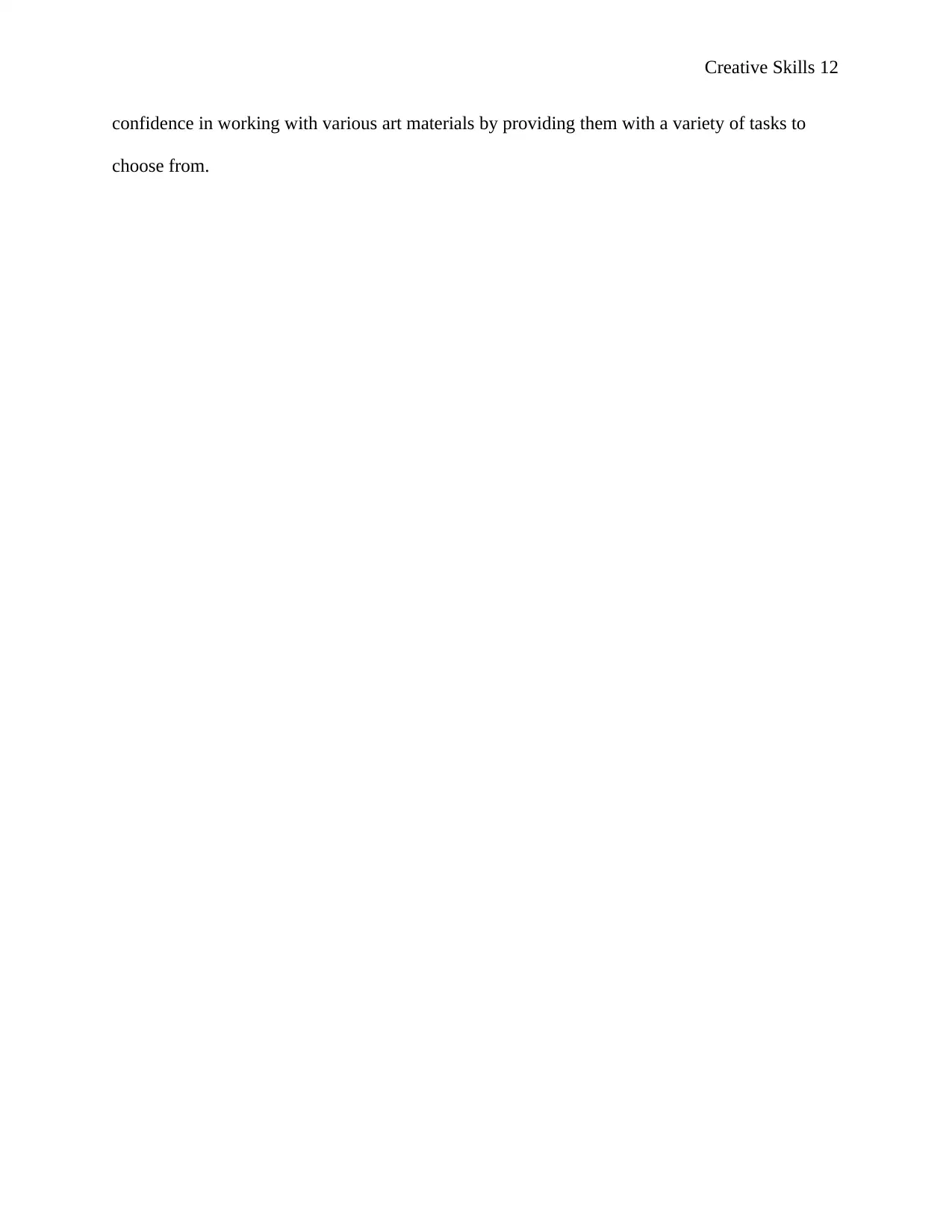
Creative Skills 12
confidence in working with various art materials by providing them with a variety of tasks to
choose from.
confidence in working with various art materials by providing them with a variety of tasks to
choose from.
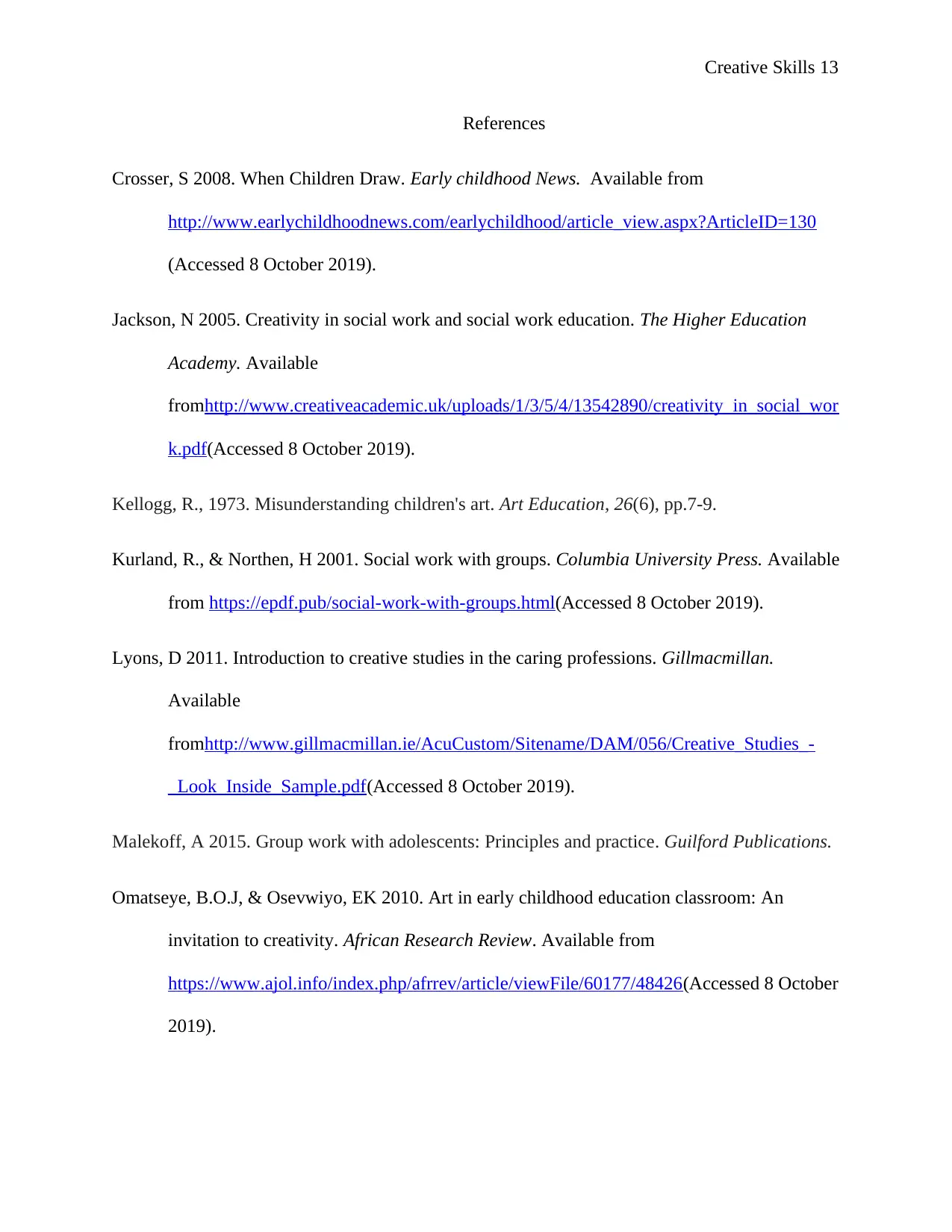
Creative Skills 13
References
Crosser, S 2008. When Children Draw. Early childhood News. Available from
http://www.earlychildhoodnews.com/earlychildhood/article_view.aspx?ArticleID=130
(Accessed 8 October 2019).
Jackson, N 2005. Creativity in social work and social work education. The Higher Education
Academy. Available
fromhttp://www.creativeacademic.uk/uploads/1/3/5/4/13542890/creativity_in_social_wor
k.pdf(Accessed 8 October 2019).
Kellogg, R., 1973. Misunderstanding children's art. Art Education, 26(6), pp.7-9.
Kurland, R., & Northen, H 2001. Social work with groups. Columbia University Press. Available
from https://epdf.pub/social-work-with-groups.html(Accessed 8 October 2019).
Lyons, D 2011. Introduction to creative studies in the caring professions. Gillmacmillan.
Available
fromhttp://www.gillmacmillan.ie/AcuCustom/Sitename/DAM/056/Creative_Studies_-
_Look_Inside_Sample.pdf(Accessed 8 October 2019).
Malekoff, A 2015. Group work with adolescents: Principles and practice. Guilford Publications.
Omatseye, B.O.J, & Osevwiyo, EK 2010. Art in early childhood education classroom: An
invitation to creativity. African Research Review. Available from
https://www.ajol.info/index.php/afrrev/article/viewFile/60177/48426(Accessed 8 October
2019).
References
Crosser, S 2008. When Children Draw. Early childhood News. Available from
http://www.earlychildhoodnews.com/earlychildhood/article_view.aspx?ArticleID=130
(Accessed 8 October 2019).
Jackson, N 2005. Creativity in social work and social work education. The Higher Education
Academy. Available
fromhttp://www.creativeacademic.uk/uploads/1/3/5/4/13542890/creativity_in_social_wor
k.pdf(Accessed 8 October 2019).
Kellogg, R., 1973. Misunderstanding children's art. Art Education, 26(6), pp.7-9.
Kurland, R., & Northen, H 2001. Social work with groups. Columbia University Press. Available
from https://epdf.pub/social-work-with-groups.html(Accessed 8 October 2019).
Lyons, D 2011. Introduction to creative studies in the caring professions. Gillmacmillan.
Available
fromhttp://www.gillmacmillan.ie/AcuCustom/Sitename/DAM/056/Creative_Studies_-
_Look_Inside_Sample.pdf(Accessed 8 October 2019).
Malekoff, A 2015. Group work with adolescents: Principles and practice. Guilford Publications.
Omatseye, B.O.J, & Osevwiyo, EK 2010. Art in early childhood education classroom: An
invitation to creativity. African Research Review. Available from
https://www.ajol.info/index.php/afrrev/article/viewFile/60177/48426(Accessed 8 October
2019).
Paraphrase This Document
Need a fresh take? Get an instant paraphrase of this document with our AI Paraphraser
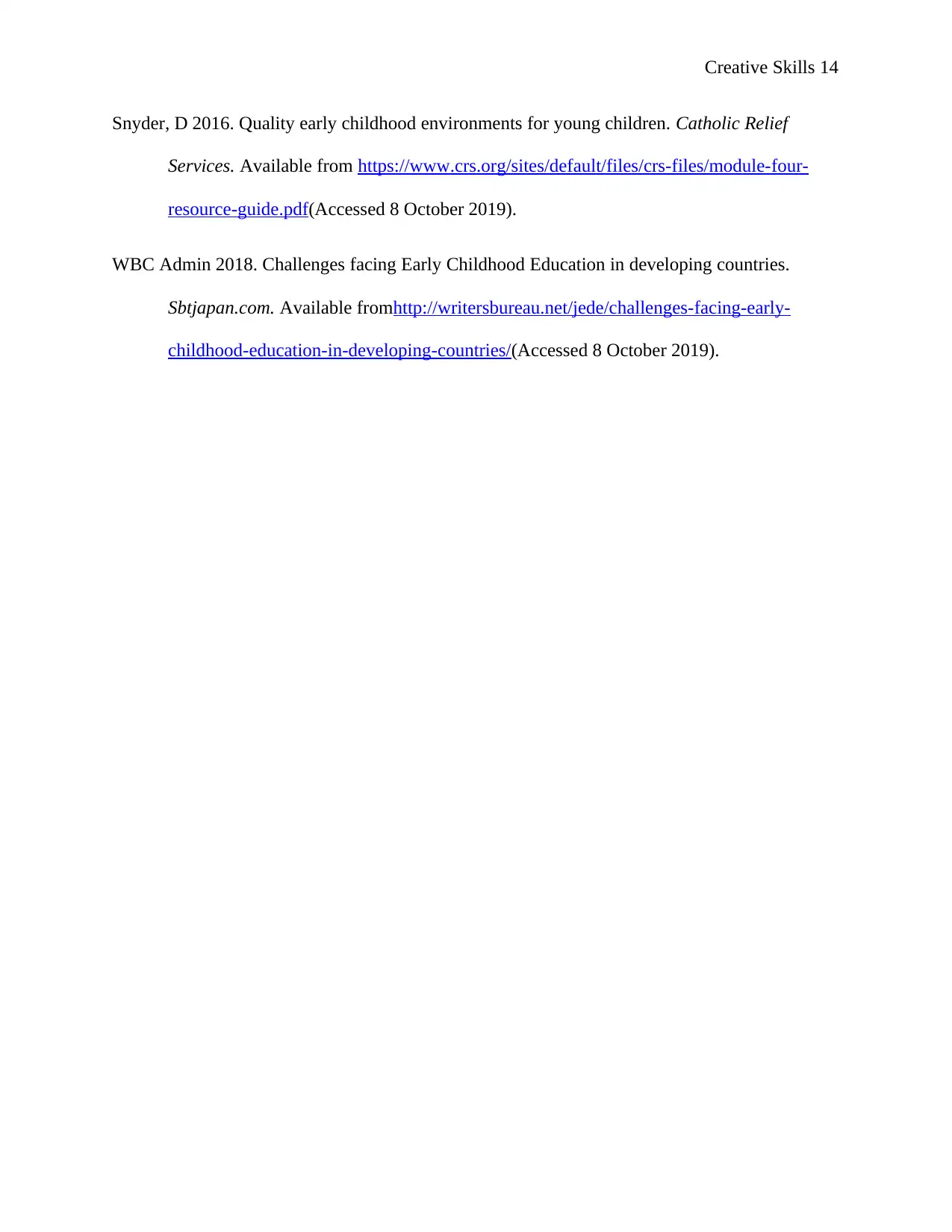
Creative Skills 14
Snyder, D 2016. Quality early childhood environments for young children. Catholic Relief
Services. Available from https://www.crs.org/sites/default/files/crs-files/module-four-
resource-guide.pdf(Accessed 8 October 2019).
WBC Admin 2018. Challenges facing Early Childhood Education in developing countries.
Sbtjapan.com. Available fromhttp://writersbureau.net/jede/challenges-facing-early-
childhood-education-in-developing-countries/(Accessed 8 October 2019).
Snyder, D 2016. Quality early childhood environments for young children. Catholic Relief
Services. Available from https://www.crs.org/sites/default/files/crs-files/module-four-
resource-guide.pdf(Accessed 8 October 2019).
WBC Admin 2018. Challenges facing Early Childhood Education in developing countries.
Sbtjapan.com. Available fromhttp://writersbureau.net/jede/challenges-facing-early-
childhood-education-in-developing-countries/(Accessed 8 October 2019).
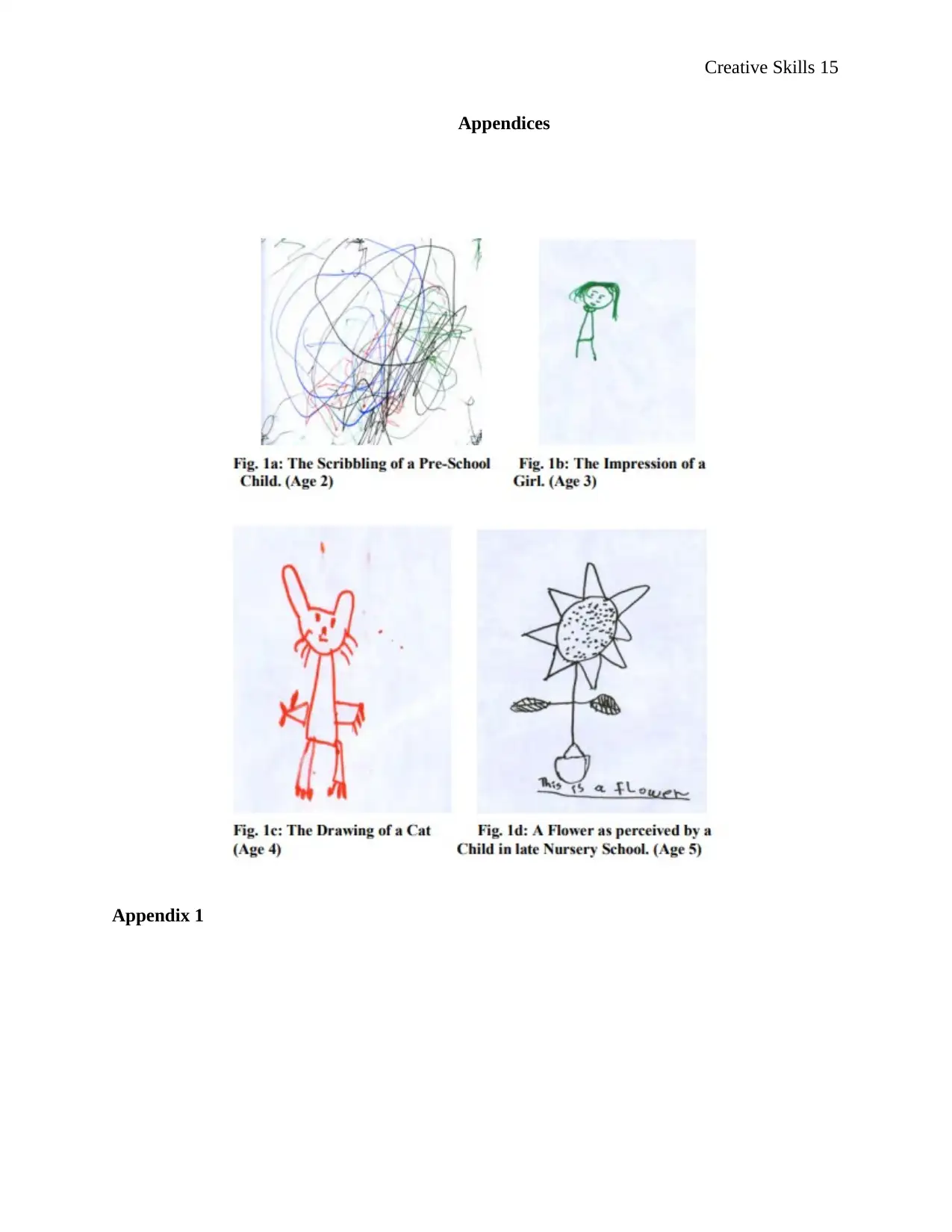
Creative Skills 15
Appendices
Appendix 1
Appendices
Appendix 1
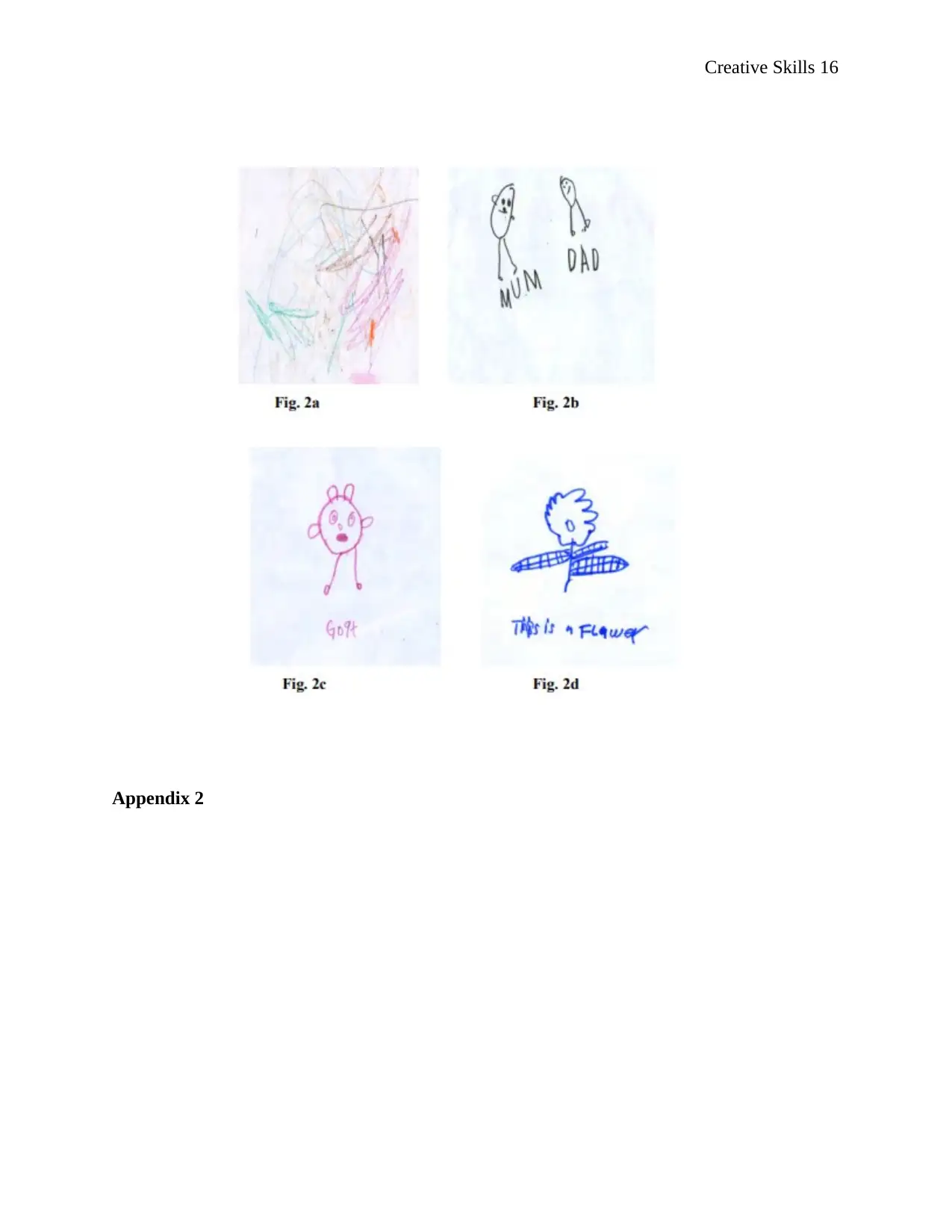
Creative Skills 16
Appendix 2
Appendix 2
1 out of 16
Your All-in-One AI-Powered Toolkit for Academic Success.
+13062052269
info@desklib.com
Available 24*7 on WhatsApp / Email
![[object Object]](/_next/static/media/star-bottom.7253800d.svg)
Unlock your academic potential
© 2024 | Zucol Services PVT LTD | All rights reserved.